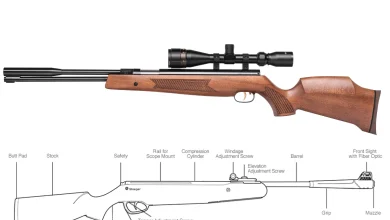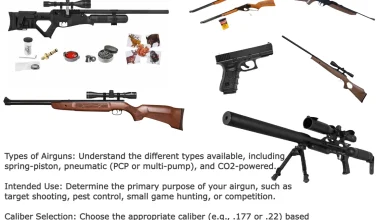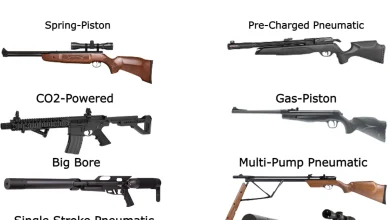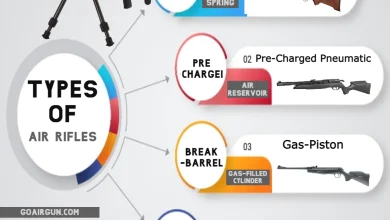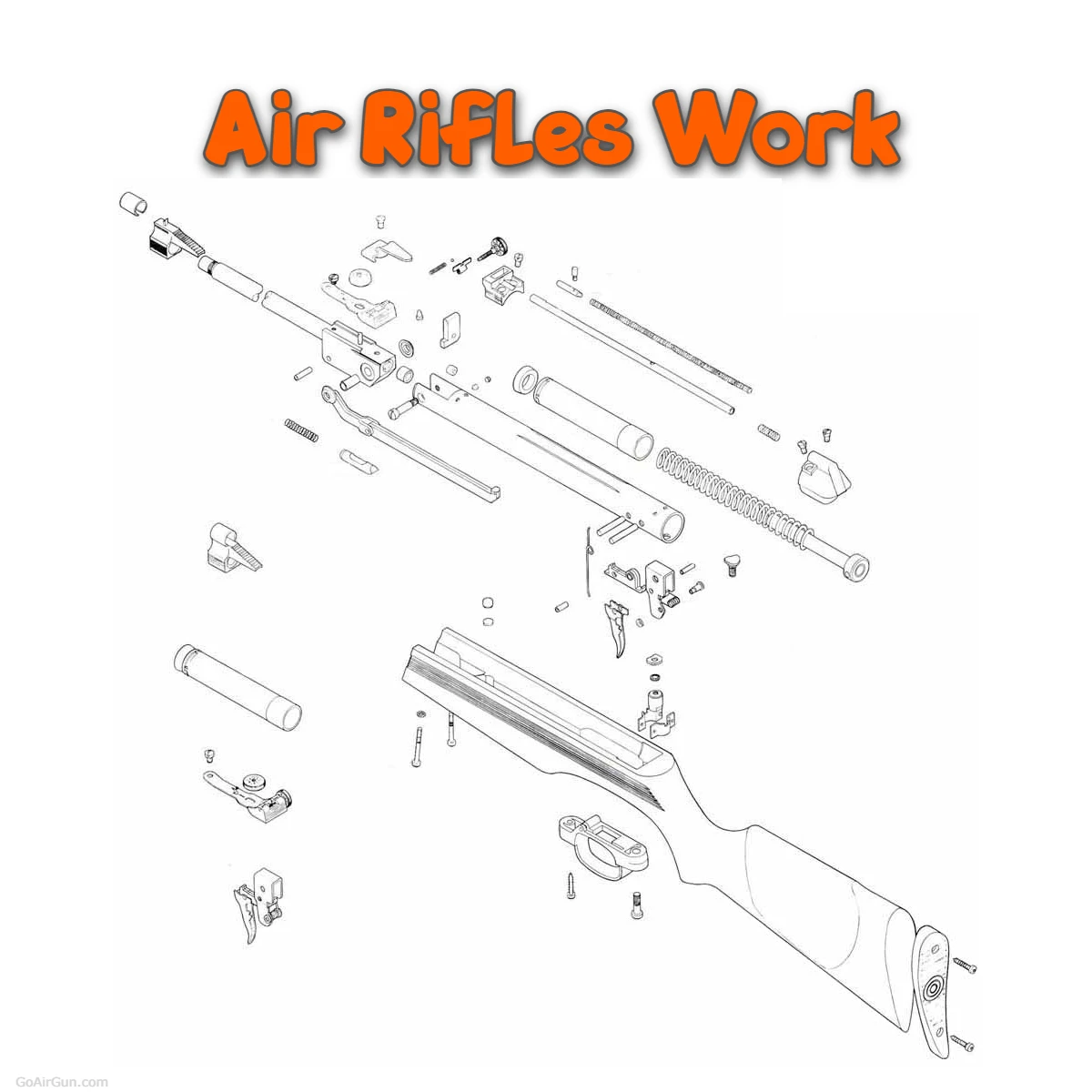
Air rifles operate on the principle of using compressed air to propel projectiles, creating a controlled burst of energy for accurate shooting. These rifles come in various types, each with its own mechanism. Spring-piston air rifles use a spring-loaded piston within a compression chamber, which, when cocked, stores potential energy. Pulling the trigger releases the spring, compressing the air and propelling the pellet down the barrel.
Precharged pneumatic (PCP) air rifles, on the other hand, rely on pre-compressed air stored in a reservoir. Trigger pull opens a valve, releasing the compressed air in a controlled manner to launch the projectile. Additionally, CO2-powered air rifles employ cartridges filled with pressurized carbon dioxide gas. When the trigger is pulled, a valve releases the gas, rapidly expanding it to create the force needed for propulsion. Understanding these mechanisms sheds light on how air rifles achieve precision and accuracy in shooting sports.
The Heart of the Matter: How Air Rifles Work
At the core of every air rifle is a simple yet ingenious concept: harnessing the power of compressed air to launch projectiles. Whether you’re a competitive shooter or a hobbyist, understanding the mechanics behind this process can enhance your appreciation for these versatile tools.
Air Compression: Creating Power with Air
The journey of a fired air rifle shot begins with air compression. When you load a pellet or a BB into the rifle’s chamber and cock the gun, you’re essentially preparing it for action. This action often involves compressing air, and this is where different types of air rifles diverge.
Spring-Piston Air Rifles: These rifles employ a spring-loaded piston housed within a compression chamber. As you cock the rifle by pulling back the barrel or an underlever, you compress the spring. Upon trigger pull, the spring releases its stored energy, pushing the piston forward. The piston compresses the air in the chamber, creating a surge of pressurized air that propels the pellet out of the barrel.
Precharged Pneumatic (PCP) Air Rifles: In contrast, PCP air rifles rely on pre-compressed air as their power source. These rifles feature a high-pressure air reservoir, often filled using a hand pump or a compressed air source. When you pull the trigger, a valve opens, releasing a controlled burst of compressed air behind the projectile. The regulated nature of PCP rifles allows for consistent shots and higher power levels.
CO2-Powered Air Rifles: Another category involves CO2-powered air rifles, which utilize small CO2 cartridges. These cartridges contain pressurized carbon dioxide gas, which expands when released. When the trigger is pulled, a valve opens, allowing the CO2 gas to expand rapidly. This expansion generates the force needed to propel the projectile.
Projectile Propulsion: Firing with Precision
With the air compressed and the trigger pulled, the real magic happens: the propulsion of the projectile. Regardless of the power source, the principles of physics dictate the trajectory of the fired shot.
Barrel and Rifling: The barrel of an air rifle plays a crucial role in accuracy. Most barrels are rifled, meaning they feature spiral grooves on the inside. As the pellet travels down the barrel, these grooves cause it to spin around its axis, much like a quarterback’s spiral pass. This spin stabilizes the projectile in flight, counteracting forces that could cause it to tumble and ensuring a more accurate shot.
Air Release and Velocity: The manner in which the compressed air is released also affects the shot’s velocity and accuracy. Spring-piston rifles release air in a single burst, which can lead to a slight kick or recoil. PCP rifles, on the other hand, release air in a more controlled manner, often resulting in less recoil and a smoother shooting experience.
Exploring Types of Air Rifles
Air rifles come in various types, each catering to different shooting preferences and needs. Let’s take a closer look at the most common categories:
Spring-Piston Air Rifles
Spring-piston air rifles, also known as “springers,” are a classic choice for many shooters. Their mechanical simplicity and affordability make them an attractive option for beginners and experienced marksmen alike.
Advantages:
- Affordability: Springers are often more budget-friendly compared to other types of air rifles.
- Self-Contained Power Source: These rifles don’t require external air sources or CO2 cartridges; the power comes from cocking the rifle.
Considerations:
- Cocking Effort: Cocking a spring-piston rifle can require a significant amount of effort, which might affect accuracy, especially during prolonged shooting sessions.
- Recoil: The recoil produced when the spring releases can impact accuracy, requiring shooters to master proper technique.
Precharged Pneumatic (PCP) Air Rifles
PCP air rifles are celebrated for their consistency and accuracy. While they require some additional equipment, they offer a premium shooting experience favored by serious marksmen.
Advantages:
- Consistency: PCP rifles offer consistent shot-to-shot velocity, resulting in tighter groupings and enhanced accuracy.
- Adjustability: Many PCP rifles allow users to adjust the power level and pressure, catering to various shooting scenarios.
Considerations:
- Initial Investment: PCP rifles can be more expensive, and you’ll need a high-pressure air source for refills.
- Maintenance: Regular maintenance of seals, valves, and the air reservoir is necessary to ensure optimal performance.
CO2-Powered Air Rifles
CO2-powered air rifles are known for their ease of use and convenience. They’re a great option for plinking and casual shooting.
Advantages:
- Ease of Use: CO2 rifles are easy to cock and shoot, making them suitable for beginners and recreational shooters.
- Minimal Recoil: These rifles generally have less recoil, contributing to accurate shooting, especially at shorter distances.
Considerations:
- CO2 Cartridges: You’ll need a supply of CO2 cartridges, which may add to ongoing costs.
- Temperature Sensitivity: CO2’s performance can be affected by temperature changes, leading to variations in shot velocity.
Factors Influencing Air Rifle Performance
As you explore the world of air rifles, several factors come into play when it comes to their performance and your shooting experience.
Caliber: Choosing the Right Size
Air rifles come in various calibers, with .177 and .22 being the most common. Each caliber has its advantages and is suited to different shooting scenarios.
- .177 Caliber: Smaller and faster, .177 pellets offer a flatter trajectory and are often chosen for target shooting and pest control at shorter distances.
- .22 Caliber: Heavier and slower, .22 pellets deliver more energy and are favored for hunting due to their greater stopping power.
Optics: Aiming for Accuracy
Equipping your air rifle with the right optics can drastically improve your accuracy and shooting experience. There are two main types of optics to consider:
- Iron Sights: These basic sights come built-in or can be added to your rifle. They consist of a front sight and a rear sight, helping you align your shot without magnification.
- Scopes: Rifle scopes offer magnification and improved aiming precision. When choosing a scope, consider factors like magnification power, objective lens diameter, and reticle type.
Pellet Selection: Finding the Perfect Match
The choice of pellets greatly influences your rifle’s accuracy and performance. Pellets are available in various shapes, weights, and materials.
- Pellet Shape: Pellets come in diabolo shape, which features a narrow waist. This design enhances stability and accuracy during flight.
- Pellet Weight: Heavier pellets tend to carry more energy and offer better penetration, making them suitable for hunting. Lighter pellets are often chosen for target shooting.
- Pellet Material: Lead pellets are common and offer good accuracy. Alloy pellets are lighter and can achieve higher velocities, but they may sacrifice some accuracy.
Shooting Technique: Mastering the Art
Regardless of the type of air rifle you choose, honing your shooting technique is essential for consistent accuracy.
- Stance: Adopt a stable shooting stance, whether standing, kneeling, or prone. A solid foundation reduces body movement and helps maintain accuracy.
- Breathing: Control your breathing to minimize movement. Take a breath, exhale halfway, and then take your shot during the natural pause in your breath cycle.
- Trigger Control: Gently squeeze the trigger instead of jerking it. This minimizes movement and prevents the rifle from shifting off target.
Maintenance and Care: Keeping Your Air Rifle in Prime Condition
Owning an air rifle isn’t just about shooting; it also involves responsible maintenance and care to ensure optimal performance and longevity. Just like any precision tool, air rifles require attention and occasional upkeep to stay in top shape.
1. Cleaning and Lubrication: Preserving Performance
Regular cleaning and lubrication are crucial to keep your air rifle functioning smoothly and consistently. Here’s how to maintain your rifle:
- Cleaning the Barrel: Use a cleaning rod, patches, and a non-abrasive solvent to clean the barrel. Make sure to push the cleaning rod from the breech end (where the pellet is loaded) to the muzzle end. Cleaning removes residue that can accumulate and affect accuracy.
- Lubricating Moving Parts: Different air rifles have various mechanisms that require lubrication. Spring-piston rifles, for example, need lubrication on the mainspring and other moving parts. Use high-quality lubricants designed for air rifles, as improper lubrication can lead to damage.
2. Storage and Protection: Safeguarding Your Investment
Proper storage helps prevent rust, dust buildup, and other potential issues that can arise when your air rifle isn’t in use.
- Dry Environment: Store your air rifle in a dry place to prevent moisture from causing rust and corrosion.
- Padded Case: Use a padded gun case to protect your rifle from impacts, dust, and scratches. Some cases even have compartments for accessories.
- Vertical Storage: If possible, store your air rifle vertically to prevent the barrel from warping over time.
3. Optics Maintenance: Keeping a Clear View
If you’re using a scope or other optics, taking care of them is vital for maintaining accuracy.
- Lens Cleaning: Regularly clean the lenses with a lens cloth designed for optics. If the lenses are dirty, your sight picture will be compromised.
- Scope Covers: Use scope covers when your air rifle isn’t in use to prevent dust and debris from accumulating on the lenses.
- Re-Zeroing: If you remove your scope for any reason, you might need to re-zero it (adjust it for accuracy) when you put it back on.
4. Safety and Responsible Shooting: A Priority
Beyond maintenance, safety and responsible shooting practices should always be your top priority.
- Always Point in a Safe Direction: Whether your air rifle is loaded or not, always point it in a safe direction – away from people, animals, and anything you don’t intend to shoot.
- Use Proper Pellets: Only use pellets recommended for your air rifle’s caliber. Using incorrect pellets can damage your rifle and compromise accuracy.
- Know Your Target and Beyond: Be aware of what’s behind your target to avoid accidental damage or injury.
Choosing the Right Air Rifle for You: A Personal Decision
Selecting the perfect air rifle involves considering a variety of factors, from your shooting preferences to your budget. Let’s delve into some key aspects to help you make an informed decision:
Intended Use: What’s Your Focus?
The first question to ask is what you plan to do with your air rifle. Are you interested in target shooting, plinking, pest control, or hunting? Each activity might steer you toward a specific type of air rifle:
- Target Shooting: If accuracy is your goal and you’ll be shooting at paper targets, a spring-piston or PCP rifle with consistent accuracy is a good choice.
- Plinking: For casual shooting at cans and other targets for fun, a CO2-powered or spring-piston rifle could be ideal.
- Pest Control and Hunting: If you plan to use your air rifle for pest control or hunting, consider a .22 caliber rifle for its stopping power.
Budget: Finding the Right Balance
Air rifles come in a wide price range, so it’s important to establish a budget that suits your needs and expectations. Keep in mind that while you may spend more upfront for a higher-quality rifle, the performance and longevity can justify the investment.
Comfort and Ergonomics: A Personal Fit
The feel of an air rifle in your hands matters. Consider factors such as weight, balance, and overall ergonomics. Some rifles have adjustable stocks to cater to different body types and shooting styles.
Accessories and Customization: Making It Your Own
Depending on your preferences, you might want to customize your air rifle with accessories like bipods, slings, and different optics. Make sure the rifle you choose is compatible with the accessories you have in mind or offers customization options.
Experience Level: From Novice to Pro
Your experience level plays a role in choosing the right air rifle. Beginners might find spring-piston rifles more approachable due to their simplicity, while seasoned marksmen might appreciate the precision and versatility of PCP rifles.
Exploring Shooting Techniques: Enhancing Your Accuracy
Mastering the art of shooting goes beyond selecting the right rifle – your technique plays a significant role in achieving consistent accuracy. Here are some essential shooting techniques to consider:
Stance: The Foundation of Accuracy
Your stance provides the foundation for a stable shot. The three most common stances are:
- Standing: Stand with your feet shoulder-width apart, with a slight bend in your knees. Keep your body relaxed and avoid locking your elbows.
- Kneeling: Place one knee on the ground and the other foot flat. Rest your forward elbow on your forward knee for support.
- Prone: Lie flat on the ground with your body aligned with the target. Use a bipod or your supporting hand for stability.
Breathing: Controlling Your Rhythm
Proper breathing control prevents unnecessary movement during the critical moment of shooting.
- Natural Respiratory Pause: As you inhale and exhale, there’s a moment when your body naturally pauses between breaths. This is the ideal time to take your shot.
3. Trigger Control: Smooth and Steady
Jerking the trigger is a common mistake that can lead to inaccurate shots. Instead, focus on a smooth, steady squeeze.
- Follow Through: After the shot is fired, maintain your position and focus on the target for a moment. This helps prevent any last-minute movement that could affect accuracy.
Embracing the World of Air Rifle
As you embark on your journey into the realm of air rifles, you’ll discover a world of precision, skill, and excitement. Whether you’re drawn to the simplicity of a spring-piston rifle, the consistency of a PCP, or the ease of use of a CO2-powered rifle, each type offers its own unique advantages. With the right combination of factors – from caliber to optics, pellets to technique – you can unlock the full potential of your chosen air rifle. So take aim, breathe steady, and let the power of compressed air propel you into a thrilling and accurate shooting experience.
FAQs
Air rifles generate power through the use of compressed air. When you cock the rifle, whether by breaking the barrel, using an underlever, or through other mechanisms, you compress air or a spring. When you pull the trigger, this stored energy is released, causing the compressed air to expand rapidly and propel the projectile down the barrel.
Spring-Piston Air Rifles: These rifles use a spring-loaded piston to compress air. Cocking the rifle compresses the spring, which releases its energy upon trigger pull to propel the pellet.
Precharged Pneumatic (PCP) Air Rifles: PCP rifles are powered by pre-compressed air stored in a reservoir. When you shoot, a valve opens, releasing controlled bursts of compressed air to push the pellet.
CO2-Powered Air Rifles: These rifles use small CO2 cartridges. Trigger pull releases pressurized CO2 gas, which expands rapidly, creating the force needed to propel the pellet.
Caliber refers to the diameter of the pellet. .177 and .22 calibers are the most common. .177 pellets are smaller, faster, and offer a flatter trajectory, making them popular for target shooting. .22 pellets are heavier and slower, providing more energy and better penetration, suitable for hunting and pest control.
No, air rifles require specially designed pellets, not regular bullets used in firearms. Regular bullets are too large and too powerful for the mechanisms of air rifles, which could lead to dangerous situations and damage to the rifle.
Yes, but the recoil in air rifles is generally milder than in firearms. Spring-piston rifles produce a noticeable recoil due to the spring’s release, while PCP rifles have less recoil due to the controlled release of compressed air. CO2-powered rifles have minimal recoil.
Air rifles can be extremely accurate, especially when used for target shooting or pest control at reasonable distances. While firearms might have the edge in terms of range and stopping power, air rifles excel in delivering precise shots with less noise and lower cost of ammunition.
Yes, air rifles are suitable for hunting, especially small game and pests. .22 caliber air rifles are often preferred for their stopping power. However, always check local laws and regulations regarding hunting with air rifles in your area.
Yes, many air rifles can be modified or customized to a certain extent. You can add accessories like scopes, bipods, and slings to enhance your shooting experience. However, be mindful of local laws and manufacturer guidelines, as excessive modifications can impact the rifle’s safety and performance.
Store your air rifle in a dry place, preferably in a padded case, to protect it from moisture, dust, and impacts. Regularly clean the barrel and lubricate moving parts to ensure smooth operation. Follow manufacturer recommendations for maintenance and store any accessories properly.
Yes, air rifles are often recommended for beginners due to their lower recoil, lower noise level, and ease of use. However, safety remains a top priority. Beginners should receive proper training, understand safety rules, and practice responsible shooting techniques.
Read More:
